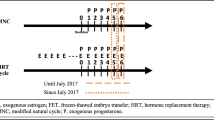Abstract
Purpose
In fresh IVF cycles, embryos reaching the eight-cell stage on day 3 of development are thought to have a higher chance of implantation than those reaching this stage on day 4. To determine whether this difference persists after cryopreservation, we compared pregnancy and implantation rates between frozen embryo transfer (FET) cycles using delayed cleavage-stage embryos (cryopreserved day 4) and normal cleavage-stage embryos (cryopreserved day 3).
Methods
Participants underwent FET between 2008 and 2012 using embryos cryopreserved on either day 3 (n = 76) or day 4 (n = 48), depending on the length of time needed to achieve the eight-cell stage. All embryos, regardless of day of cryopreservation, were thawed and transferred on the 4th day of vaginal progesterone following endometrial preparation with oral estradiol. Chi-square and Mann-Whitney U tests were used to compare patient demographics and cycle outcomes.
Results
More women in the day 4 group had diminished ovarian reserve (44 vs 16 %, p = 0.003). Pregnancy outcomes in preceding fresh cycles were not different between the two groups. Pregnancy, implantation, and live birth rates following FET did not differ between the day 3 and day 4 groups.
Conclusions
This is the first study to address outcomes using day 3 versus day 4 cryopreserved embryos. Despite a higher prevalence of diminished ovarian reserve (DOR) in the day 4 group, delayed cleavage-stage embryos utilized in FET cycles performed as well as embryos growing at the normal rate, suggesting delayed embryo development does not affect embryo implantation as long as endometrial synchrony is maintained.
Similar content being viewed by others
References
Trounson A, Mohr L. Human pregnancy following cryopreservation, thawing and transfer of an eight-cell embryo. Nature. 1983;305:707–9.
De Mouzon J, Goossens V, Bhattacharya S, Castilla JA, Ferraretti AP, Korsak V, et al. Assisted reproductive technology in Europe, 2006: results generated from European registers by ESHRE. Hum Reprod. 2010;25:1851–62.
Society for Assisted Reproductive Technology National Data Summary. Available at https://www.sartcorsonline.com/rptCSR_PublicMultYear.aspx?ClinicPKID=0. Accessed on Jan 31, 2015.
Rhenman A, Berglund L, Brodin T, Olovsson M, Milton K, Hadziosmanovic N, et al. Which set of embryo variables is most predictive for live birth? A prospective study in 6252 single embryo transfers to construct an embryo score for the ranking and selection of embryos. Hum Reprod. 2015;30:28–36.
van Loendersloot L, van Wely M, van der Veen F, Bossuyt P, Repping S. Selection of embryos for transfer in IVF: ranking embryos based on their implantation potential using morphological scoring. Reprod Biomed Online. 2014;29:222–30.
Holte J, Berglund L, Milton K, Garello C, Gennarelli G, Revelli A, et al. Construction of an evidence-based integrated morphology cleavage embryo score for implantation potential of embryos scored and transferred on day 2 after oocyte retrieval. Hum Reprod. 2007;22:548–57.
Fisch JD, Rodriguez H, Ross R, Overby G, Sher G. The Graduated Embryo Score (GES) predicts blastocyst formation and pregnancy rate from cleavage-stage embryos. Hum Reprod. 2001;16:1970–5.
El-Toukhy T, Wharf E, Walavalkar R, Singh A, Bolton V, Khalaf Y, et al. Delayed blastocyst development does not influence the outcome of frozen–thawed transfer cycles. BJOG. 2011;118:1551–6.
Levens ED, Whitcomb BW, Hennessy S, James AN, Yauger BJ, Larsena FW. Blastocyst development rate impacts outcome in cryopreserved blastocyst transfer cycles. Fertil Steril. 2008;90:2138–43.
Harris PA, Taylor R, Thielke R, Payne J, Gonzalez N, Conde JG. Research electronic data capture (REDCap)—a metadata-driven methodology and workflow process for providing translational research informatics support. J Biomed Inform. 2009;42:377–81.
Saadat P, Boostanfar R, Slater CC, Tourgeman DE, Stanczyk FZ, Paulson RJ. Accelerated endometrial maturation in the luteal phase of cycles utilizing controlled ovarian hyperstimulation: impact of gonadotropin-releasing hormone agonists versus antagonists. Fertil Steril. 2004;82:167–71.
Zhao P, Li M, Lian Y, Zheng X, Liu P, Qiao J. The clinical outcomes of day 3 4-cell embryos after extended in vitro culture. J Assist Reprod Genet. 2015;32(1):55–60.
Author information
Authors and Affiliations
Corresponding author
Additional information
Capsule
Developmentally delayed cleavage-stage embryos that reach the eight-cell stage or better by day 4 have similar outcomes in frozen cycles to normal embryos when synchronized to endometrial development.
Rights and permissions
About this article
Cite this article
Burks, H., Buckbinder, J., Francis-Hernandez, M. et al. Developmentally delayed cleavage-stage embryos maintain comparable implantation rates in frozen embryo transfers. J Assist Reprod Genet 32, 1477–1481 (2015). https://doi.org/10.1007/s10815-015-0561-8
Received:
Accepted:
Published:
Issue Date:
DOI: https://doi.org/10.1007/s10815-015-0561-8




